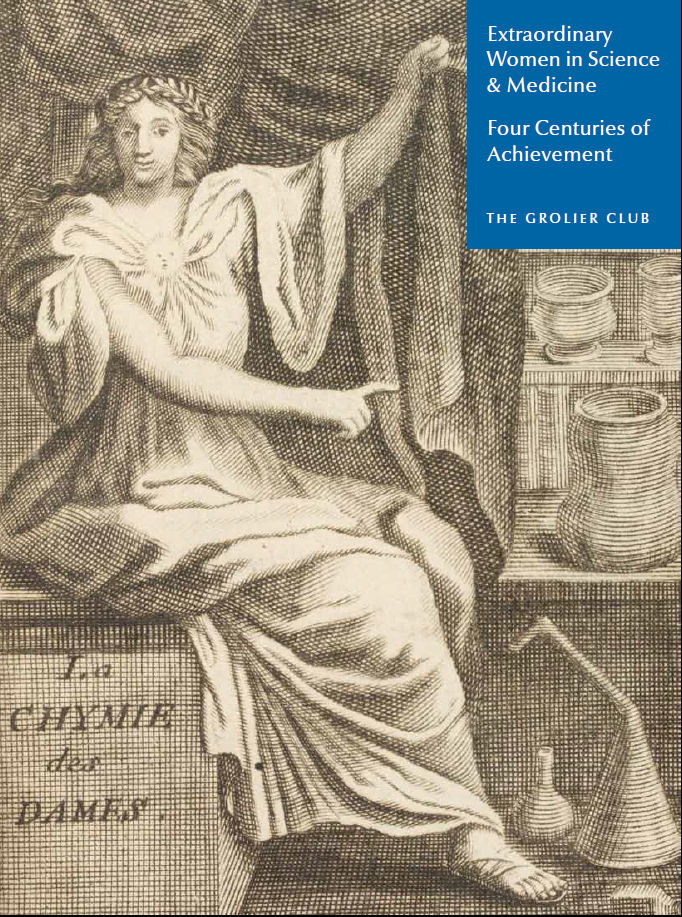|
September 18 - November 23, 2013. "Extraordinary Women in Science & Medicine: Four Centuries of Achievement." Curated by Ronald K. Smeltzer, Paulette Rose, and Robert J. Ruben.
|
|
|
Print |
September 18 - November 23, 2013
Extraordinary Women in Science & Medicine: Four Centuries of Achievement
Curated by Ronald K. Smeltzer, Paulette Rose, and Robert J. Ruben
The landmark public exhibition Extraordinary Women in Science & Medicine: Four Centuries of Achievement explores the legacy of thirty-two remarkable women whose extraordinary accomplishments in physics, chemistry, astronomy, mathematics, computing,  and medicine contributed to the advancement of science. On view at the Grolier Club from September 18 through November 23, 2013, the show illuminates the often little-known careers of these female scientists, examining their work and lives over four centuries. More than 150 original items, comprising books, manuscripts, periodicals, offprints, dissertations, and laboratory apparatus (such as that used by Marie Curie during her earliest work on radioactivity) are on view, providing a remarkable overview of the scientific contributions of this eminent group. Lenders to the exhibition include the libraries of the American Philosophical Society, Columbia University, National Library of Medicine, The Morgan Library, New York Academy of Medicine, Yale University as well as several private collections. and medicine contributed to the advancement of science. On view at the Grolier Club from September 18 through November 23, 2013, the show illuminates the often little-known careers of these female scientists, examining their work and lives over four centuries. More than 150 original items, comprising books, manuscripts, periodicals, offprints, dissertations, and laboratory apparatus (such as that used by Marie Curie during her earliest work on radioactivity) are on view, providing a remarkable overview of the scientific contributions of this eminent group. Lenders to the exhibition include the libraries of the American Philosophical Society, Columbia University, National Library of Medicine, The Morgan Library, New York Academy of Medicine, Yale University as well as several private collections.
Among the twentieth-century luminaries of the physical sciences are Marie and Irène Curie, Marietta Blau, Lise Meitner, Maria Goeppert Mayer, C.-S. Wu, Dorothy Crowfoot Hodgkin, and Rosalind Franklin in physics and chemistry. In astronomy, Maria Cunitz, the most advanced scholar in mathematical astronomy of the seventeenth century, and Cecilia Payne-Gaposchkin, whose Ph.D. thesis in 1925 was the beginning of modern astrophysics are presented. Nineteenth-century mathematicians highlighted are Sophie Germain, Sophie Kowalevski, and Florence Nightingale—for her work in statistics. The preeminent twentieth-century mathematician Emmy Noether is included. Represented also are such eighteenth-century women as the physicist Laura Bassi, the mathematician Maria Agnesi, and two chemists, Marie Thiroux d’Arconville and Elizabeth Fulhame. Featured in computing are Ada, Countess of Lovelace—the daughter of Lord Byron and a colleague of mathematician Charles Babbage—whose 1843 paper is generally considered the most important one in the history of computing before modern times and Grace Hopper, the creator of many fundamental concepts in twentieth-century digital computing.
In the field of medical scientists, the exhibition features primarily 20th century women such as Gerti Cori, instrumental in unveiling the fundamental mechanism of metabolism; Gertrude Elion, the first to design medicines effective in the cure of cancer and viral diseases; Rosalyn Yalow, developer of the powerful analytic tool, radioimmunoassay; and Florence Sabin, whose discoveries form the basis for our current understanding of cellular immunity. Two game-changers in medical science are Rita Levi-Montalcini, discoverer of nerve growth factor, and Barbara McClintock who discovered that genes are not fixed but move—the key paradigm shift in modern genetics. Great and influential clinical physicians include Louise Bourgeois Boursier, late 16th to early 17th century midwife to King Henry IV and to Marie de Medici of France; the pioneering pediatric neurologist Mary Putnam Jacobi; and Helen Taussig, designer of the life-saving “blue baby” operation.
Many of the objects in the exhibition have special attributes and provenance. Of particular interest is Emilie Du Châtelet’s 1759 translation of Newton’s Principia with the bookplate of Talleyrand; copies of all of her other scientific publications; a mathematics workbook and a letter, both in her hand; and materials about her fourteen-year relationship with Voltaire, including a book she co-authored—although without her name on the title page.
The exhibition poses questions about the recognition—or lack thereof—of women in the sciences, and explores how factors such as economic status, relative lack of educational opportunities, and traditional attitudes combined to limit women’s roles in this field. At the same time, the show illustrates the remarkable extent to which women were able to overcome the limits placed on them by society.
"Extraordinary Women in Science & Medicine: Four Centuries of Achievement" is organized by Curators Ronald K. Smeltzer, Ph.D., Paulette Rose, Ph.D., and Robert J. Ruben, M.D.
The exhibition was made possible in part by generous grants from the Gladys Krieble Delmas Foundation, and the Arthur F. and Alice E. Adams Charitable Foundation.
CATALOGUE: A comprehensive illustrated catalogue of the exhibition is available at the Grolier Club, and through Oak Knoll Books.
EXHIBITION-RELATED EVENTS:
Collectors' Forum: Thursday, October 3, 2013, 6:00 – 7:30 PM
Symposium: Saturday, October 26, 2013, 12:00 Noon – 5:00 PM
Curator-led tours of the exhibition:
October 16, 23 and 30, 2013, 1:00 – 2:00 PM
Guided tours are available: please contact organizer Ronald K. Smeltzer: [email protected]
VISITING THE GROLIER CLUB
47 East 60th Street
New York, NY 10022
212-838-6690
www.grolierclub.org
Hours: Monday – Saturday, 10 am to 5 pm
Admission: Exhibitions are open to the public free of charge
For further information please contact:
Susan Flamm
Public Relations Consultant to the Grolier Club
212-289-2999
[email protected]
|
|